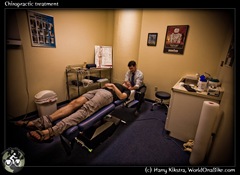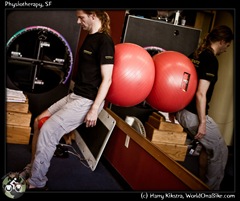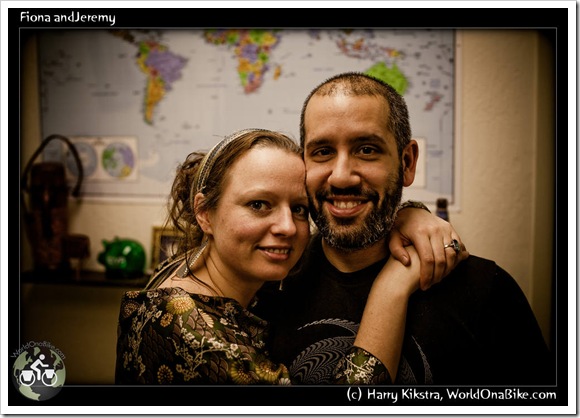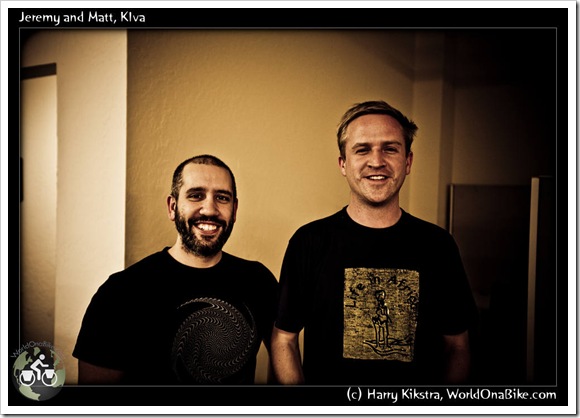Day 160-204, 18Dec08 – 31Jan09: San Francisco. Part2: doctors, civil rights and microcredits
February 2, 2009 by Harry
Filed under Trip reports, North America, USA, California
Pain, ethics & Doctors: getting treated in SF
Once we arrived in San Francisco, my knee got some rest, but it did not get better. After we moved to Bradley & Saskia’s place, I could not even walk and we spent X-mas inside the house.
I asked around and a friend of Ali referred us to a private clinic in town. I contacted them and could get a quick appointment with a doctor. She was an osteopath and very friendly and though she could not do much for my knee, she diagnosed my back and started treating immediately.
Apparently some of my vertebrae were a little ‘off’, causing the constant inflammation to the connected ribs and the pain that comes with it. As she is both a medic (she could prescribe me new medication, which helped to ease the pain) as well as a chiropractor, she could start fixing me right away.
Doctors are expensive and private clinics are even worse, but as I was a tourist, they waived the ‘membership fee’ and the doctor told me that she would see what could be done about the size of the bill. Even though we are covered by our WorldNomads insurance, it is always unclear when and how much I could get back, so I appreciated that.
She was a sportswoman herself and wanted to support our trip and offered me a free 2nd consultation a few days later. I gratefully accepted and after the 2nd treatment my back felt much better, though my knee was still incredibly painful and useless.
She told me that I could come back for another free treatment after our little road trip, but the night before our appointment I received an email. Apparently she had been reprimanded for offering free services.
(…) I have just finished a conversation with my employer who suggested that my offering to treat you here in this office “pro-bono” (for free) is ethically unsound. He has asked that I request that you not come by the office tomorrow, January 6th. The other visit that has already taken place is in the past, is “OK”, but no further visits should be allowed.(…)
 I always thought that helping patients was the thing that was ethically sound for doctors (something about oath and Hippocrates?), but I guess I was wrong. I wrote her back that I would have gladly paid for the service anyway, but after this message I would go elsewhere.
I always thought that helping patients was the thing that was ethically sound for doctors (something about oath and Hippocrates?), but I guess I was wrong. I wrote her back that I would have gladly paid for the service anyway, but after this message I would go elsewhere.
I know it was not her choice to refuse me, but for me it is ethically unsound to pay very expensive treatments just because you might get it back from the insurance.. I even paid for a $20 membership of the Walgreen pharmacy, so my medication would be (much) cheaper, even though I will get it back from WorldNomads.
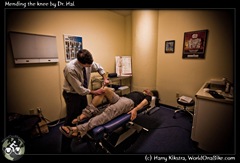 Mitch’s friend Adriana told me that her friend Hal Rosenberg was a famous Chiropractor and I should call him to schedule an appointment.
Mitch’s friend Adriana told me that her friend Hal Rosenberg was a famous Chiropractor and I should call him to schedule an appointment.
I ended up in his office a few days later and got treated right away, both for my shoulder as well as my knee. Using the Crafton technique and electronic stimulation he removed a lot of scar tissue from the knee and though the pain remained during the treatments, I could use it again.
Though I felt at times that he was aiming to kill me, the twisting and crunching of the neck and back improved the back a lot as well, though when not taking the anti-inflammatories the pain would come back quickly.
I also had a few sessions with Bobby and Steve, the in-house physical therapists, and they gave me specific exercises to strengthen the core and leg muscles that were influencing the movement of the knees. In total I had 6 appointments and though more probably would have been good, we felt that it was time to try to move on, going South again!
San Francisco: cultural diversity, faded flowerpower and civil rights
The bus and streetcars must be some of SF’s greatest and cheapest attractions. Unlike the ‘clean’ BART underground, the public transport that runs above the surface is the best way to see another face of SF. It is a continuous show of people of all types and colours: tourists, homeless people; some youth dressed-up in party gear, others completely off the planet. Some people were on their way to work, others were doing their business on the bus itself.
It reminded us about Weird Al Yankovic’s Another One Rides The Bus (video & lyrics here), especially the streetcar going down Market Street was great fun 🙂
 Other well-known aspects of San Francisco are the birth of Flower Power and the civil rights movement, especially the gay rights.
Other well-known aspects of San Francisco are the birth of Flower Power and the civil rights movement, especially the gay rights.
We visited Haight & Ashbury, the famous area where Janis Joplin, Jimi Hendrix and many other musicians and artists once lived, but got depressed by its current state: a lot of so-called cool shops, selling stuff for smoking weed and ‘spiritual’ goodies, one of the few McDonalds visible in the city, and homeless kids on the streets, many of them who look like they are there by choice and that it took a long time or a lot of money to get those clothes look ‘alternative’ and worn.
 More interesting is the nearby Castro District, birthplace of Gay Rights and still the gay capital of the USA. It has nice streets, friendly people and good little restaurants.
More interesting is the nearby Castro District, birthplace of Gay Rights and still the gay capital of the USA. It has nice streets, friendly people and good little restaurants.
It is were the movie ‘Milk’ was filmed as the historic events depicted all took place in this part of town. Not only is Sean Penn’s acting phenomenal, it was especially great to be able to see the movie in a fully packed famous Castro Theatre, which even features in the film 🙂
They included a slideshow about Harvey Milk, and an original organ player playing music while the crowds came in. The cinema was filled with locals, as every reference to local places and events were met with chuckles and comments.
 It is strange that exactly in the liberal and generally intelligent state of California a law passed on election day, which basically made it impossible for gays to get married anymore. This ‘Proposition 8’ turned back a lot of civil rights that Milk had been fighting for and we went out to join a candlelight vigil to show our support.
It is strange that exactly in the liberal and generally intelligent state of California a law passed on election day, which basically made it impossible for gays to get married anymore. This ‘Proposition 8’ turned back a lot of civil rights that Milk had been fighting for and we went out to join a candlelight vigil to show our support.
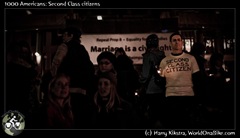 Imagine that your partner you have been living with for 20 years gets ill and you are not allowed into the Hospital for visits, or if he or she dies, and you will not be entitled to receive any of the shared memorabilia you gathered together.
Imagine that your partner you have been living with for 20 years gets ill and you are not allowed into the Hospital for visits, or if he or she dies, and you will not be entitled to receive any of the shared memorabilia you gathered together.
Somehow millions of people, who would not be harmed by equal civil rights thought that they should impose their ‘morals’ onto others, so let’s hope that this situation will be rectified and California is recognized as a forward-thinking State again…
Kiva: opportunities for entrepreneurs in developing countries
On a more positive note, we got introduced by Nate & Kim to their friend Jeremy. Coincidentally he works at Kiva, an organisation we have been supporting during our trip, so we visited their office in SF.
It was great to see the heart of the small company that has already made such a huge impact (they loaned over 60 million dollars to mostly one men/women businesses in developing countries on 5 continents).
We talked with Matt, the founder and CEO and took a look at the worldwide volunteers map, all very inspiring.
Read more about Kiva and their work here on our blog and lend (not donate) some money yourself!
San Francisco is great in many ways, but there were many things to see outside the city as well… next part, coming up soon: Snow in Truckee, bears & rocks in Yosemite, music in Berkeley and wine in Napa!
1000 Americans: Fiona & Jeremy, Kiva, San Francisco
January 28, 2009 by Harry
Filed under 1000 Americans
Fiona is Kiva’s Public Relations Director, responsible for Kiva’s exposure & communication. She lives with Kiva’s Technology Director Jeremy and together they have sacrificed much time, money and effort to get Kiva up and running, being two of the first employees.
They both love to travel the world when possible and have seen the need for and success of microcredit with their own eyes.
Read more about Kiva and how you can support them, here on our blog.
1000 Americans: Jeremy Frazao & Matt Flannery, Kiva, San Francisco
January 28, 2009 by Harry
Filed under 1000 Americans
Jeremy (Technology Director of Kiva) was one of the first people to work for Kiva after Matt (CEO of Kiva) had started the company in 2005.
Of course they both did not know then that it would mean long hours with no pay, but due to dedication of the first key people like them, Kiva survived and is now one of the most praised companies in the US, facilitating microcredit lending to entrepreneurs in developing countries.
Read more about Kiva and how you can support them, here on our blog.



